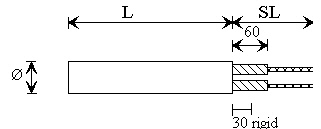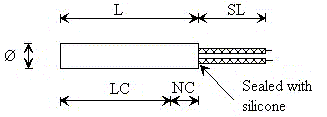CCHC
without ceramic tape |
|
|
|
| Sealed with refractory cement |
 |
| Ø CCHC | 1/4'' 6.5 |
8 | 3/8'' 10 |
1/2'' 12.5 |
5/8'' 16 |
3/4'' 20 |
| Maxi Amps (A) | 4.5 | 4.5 | 7 | 11 | 14 | 18 |
| Maxi Wattage at 230 V | 1035 | 1035 | 1600 | 2500 | 3220 | 4140 |
Fiberglass insulated wires, internally connected, for maximum flexibility where leads exit the CCHC.
Such option imposes a special launching and cannot be processed on CCHC available on stock.
![]()
| Sealed with refractory cement
Solution currently used for amps higher than on standard CCHC. Sealed end with refractory cement. Fiberglass insulated leadwires externally connected to Nickel Pin's terminals and sealed with refractory cement. |
 |
| Ø CCHC | 1/4'' 6.5 |
8 | 3/8'' 10 |
1/2'' 12.5 |
5/8'' 16 |
3/4'' 20 |
| Maxi Amps (A) | 4.5 | 4.5 | 7 | 11 | 14 | 18 |
| Maxi Wattage at 230 V | 1035 | 1035 | 1600 | 2500 | 3220 | 4140 |
Important :
All cartridges CCHC with amps values higher than listed as our standard CCHC will be manufactured as above . No ceramic tape and rigid leads.
| Sealed end with silicone rubber
The temperature of the silicone cannot exceed 250°C or it will be damaged and become porous. LC : Heating Length NC : Un-heating Length |
SL = Leads Length = 1 Meter Maxi.

|
We highly recommand you to use an un-heating length, defined according to the use and operating temperatures.
| Sealed end with silicone rubber The temperature of the silicone rubber cannot exceed 250°C or it will damage and become porous. |

|
We highly recommand you an un-heating length, defined according to the use and operating temperatures.